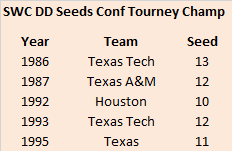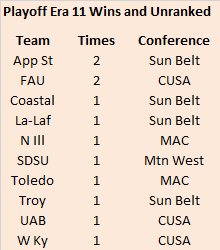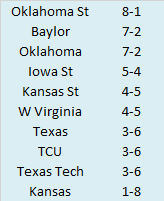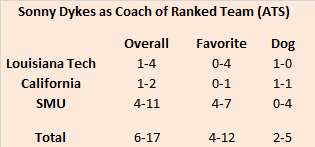Welcome readers. This is the time of year where I typically offer you advice for filling out your NCAA Tournament bracket. Novel I know. However, I don't really have any groundbreaking analysis to give other than I would be hesitant to pick Arizona to make the Final Four. See my post on the
tourney that didn't happen from two years ago to find out why. Since I don't have any advice, I figured I'd offer a history lesson instead. During major conference tournaments, we often see upsets where teams with no chance to earn at at-large bid to the NCAA Tournament win a game or two and set themselves up to earn their conferences automatic bid. Such a run happened this season with Virginia Tech storming through a down ACC (after
surviving their opening tourney game with Clemson) to claim the automatic bid. This caused me to wonder, how often has a team with no at-large ambitions gone on a hot streak and won a major conference tournament? We'll classify teams that earned a double-digit seed despite winning their conference tournament as a team with no at-large hopes. To answer that question, we first need to define what a major conference is. Most would argue, there are currently six major conferences in Division I basketball: The fives leagues that form the Power Five in FBS football (ACC, Big 10, Big 12, Pac-12, and SEC) plus the Big East. Some might argue the American and Atlantic 10 are in the same neighborhood. I would
respectfully disagree. However, that only addresses the current batch of major conferences. Since the NCAA expanded the tournament to 64 teams in 1985, some now defunct leagues could rightly lay claim to being major conferences. And that is where our journey will start, with a long forgotten conference: The
Metropolitan Collegiate Athletic Conference, or as it was known in its time, simply The Metro.
The Metro was a small conference in 1985. It consisted of eight members that played FBS football as Independents: Cincinnati, Florida State, Louisville, Memphis (then known as
Memphis State), South Carolina, Southern Miss, Tulane, and Virginia Tech. The conference produced a Final Four team in 1985 (Memphis) and the national champion in 1986 (Louisville). The Metro would last until 1995 at which point it (sort of) merged with another major conference to form a new major conference. More on that in a moment. Between 1985 and 1995, the league only had one tournament champion that would have been unlikely to make the tournament had they not won the title.
In 1987,
Memphis was on probation, so the league did not send a team to the NCAA Tournament. In 1995, the final year of the league's existence, Louisville entered the conference tournament with a mediocre 16-13 record, but won the title by beating another team with no at-large chances (Southern Miss) to earn the automatic bid.
I mentioned The Metro (sort of) merged with another conference after the 1995 season. What conference was that?
The Great Midwest of course. The Great Midwest existed for all of four seasons (1992-1995), never had more than seven members, but always sent at least three teams to the NCAA Tournament. Cincinnati won all four of the conference tournaments and never received a seed lower than 8, so we can assume they would have been in had they not earned the automatic bid.

When The Metro and The Great Midwest merged,
Conference USA was born. In the early years, the league appeared to have been engineered in a lab by a pandering right wing politician as it operated with
three divisions named, you guessed it, Red, White, and Blue. That divisional set up lasted just two seasons before the league cribbed from baseball and reconfigured to
American and National. For the first ten years of its existence, Conference USA was a major conference. The league routinely got multiple teams into the tournament and produced legitimate title contenders in Cincinnati, Louisville, and Marquette. However, conference expansion, driven by football, poached the league's best members and by 2006 it was like a lesser version of the current West Coast Conference, with Memphis playing the role of Gonzaga until
John Calipari left for Kentucky. Between 1996 and 2005, Conference USA averaged 3.8 NCAA tournament bids per season and always put at least two teams in in the tournament. Since 2006, Conference USA has sent multiple teams to the NCAA Tournament in a season just four times and has not done it since
2012. In those first ten years, a legitimate Cinderella never won the conference tournament. St Louis (2000) and Charlotte (2001) both received 9 seeds, but they probably would have gotten in had they lost in the conference finals.

Two other defunct conferences can lay claim to being major conferences during their day. And they also (sort of) merged. The Big 8 was a football power in the 1980s, with Oklahoma and Nebraska routinely turning in top-ten finishes. They were also pretty good at basketball. Oklahoma received four 1 seeds between 1985 and 1990 and Kansas won the national title in 1988. With that kind of power at the top, its no surprise there was only a single Cinderella tournament champ between 1985 and the final year of the conference in 1996.

After the 1996 season, driven by football, the Big 8 absorbed four teams from the dying
Southwest Conference (Baylor, Texas, Texas A&M, and Texas Tech) to become the Big 12. While the Southwest Conference had some schools with name cache, its basketball performance left a lot to be desired. Between 1985 and 1996, on three occasions, the Southwest Conference sent just one team to the NCAA Tournament! Most damning was that it happened two times in five seasons after their dominant program, Arkansas, realized the ship was sinking and
left for the SEC. As you can tell from the seeds some of the conference tournament champions received, the dearth of bids could have been even worse.
Was the Southwest Conference really a major conference in the late 80s and early 90s? Based on the number of bids and the seeds a few of their conference champs received, you could argue they were closer to the Missouri Valley than...
The Big 12. The conference has not really had a true Cinderella with faint at-large hopes run roughshod through the conference tournament.
Kansas in 1999 and Iowa State twenty years later earned the lowest seeds of a Big 12 tournament champion. That Kansas team finished tied for second in the regular season behind Texas and while Iowa State was a mediocre fifth in 2019, they were still likely to earn a bid had they not won the tournament.
As I was compiling the numbers for the ACC, I was shocked the conference has only produced two true Cinderella champions since the NCAA field expanded in 1985.

NC State entered the 1987 ACC Tournament with a 6-8 conference record (17-14 overall), but upset Duke in the first round, drew a bad Wake Forest team in the second round that had just upset Clemson, and then edged top-seeded North Carolina in the final. Wolfpack fans likely though the
Cardiac Pack were back and expected an NCAA Tournament run similar to the one they went on in 1983. Alas, it was not to be as NC State fell to Florida in the first round of the tournament. You could make the case for two other Cinderella runs. Two seasons after winning the national title, Maryland finished 7-9 in the ACC in 2004, but reeled off wins against three Tobacco Road teams (Wake Forest, NC State, and Duke) to claim the tournament title. The Terps were rewarded with a number 4 seed in the ensuing NCAA tournament, implying they may have been in had they lost their ACC Tournament opener. Finally, last season, Georgia Tech won the ACC Tournament thanks in part to a
Covid forfeiture in the semifinals by Virginia. However, the Yellow Jackets received a 9 seed, indicating they probably would have still been in had they played and lost to the Cavaliers.
Like the ACC, the Big East has had a lack of legitimate Cinderellas.
Providence finished tied for third in 2014 and may have been excluded had they dropped the Big East Final to Creighton. And of course, last season saw one of the most improbable runs in major conference tournament history. Georgetown entered the Big East Tournament 9-12 overall and 7-9 in the Big East. The Hoyas then won four games in four days, including a
beat down of Creighton in the final to garner a 12 seed.
The Big 10 did not begin holding a conference tournament until 1998. In the quarter century since they have staged the event, they have had two somewhat surprising winners, but both likely would have gotten in the NCAA Tournament even with a poor performance in the Big 10 Tournament.
Iowa was 7-9 in Big 10 play in 2001, but won four games in four days to earn the automatic bid. The 7 seed they earned in the NCAA tournament indicated they were likely in as long as they didn't drop the conference opener to last place Northwestern. Michigan was a more respectable 10-8 in Big 10 play in 2017 and despite some
aeronautical adventures, they also managed four wins in four days to capture the league tournament.
The Pac-12 (then known as the Pac-10) started its conference tournament relatively late in the game (1987) and only contested it for four seasons before putting it on hiatus after 1990. The conference obviously realized the money they were missing out on and resumed it in 2002. In the twenty tournaments the conference has held since it was rebooted, six have been won by teams that did not harbor legitimate at-large hopes heading into the conference tournament.
The biggest surprise was probably Oregon State in 2021. The Beavers entered the tournament 10-10 in Pac-12 play (and just 14-12 overall) before winning three consecutive games to grab the automatic bid. Their hot streak continued in the NCAA Tournament as they also won three straight to advance to the regional final for the first time since
1982.
And finally we come to the SEC, where the biggest major conference tournament Cinderella run occurred. And all it took was an
act of god.
Aside from Georgia's magical run in 2008, Auburn, Arkansas, and both Mississippi schools have garnered surprise NCAA Tournament bids after winning the SEC Tournament. Georgia received the lowest NCAA Tournament seed (14) of any major conference tournament winner and helped
Dennis Felton cash checks for a few more months before he was eventually fired midway through the following season.
Sorry if you swung by expecting a bracket breakdown or some advice on who to pick in a first round upset. But if you stuck around, I hope you leave with a little more knowledge and an appreciation of all the surprise major conference tournament winners. We'll be back to our normal posting schedule next week, with a look at the
Adjusted Pythagorean Record in Conference USA. See you then.





.png)
.png)
.png)

.png)



























